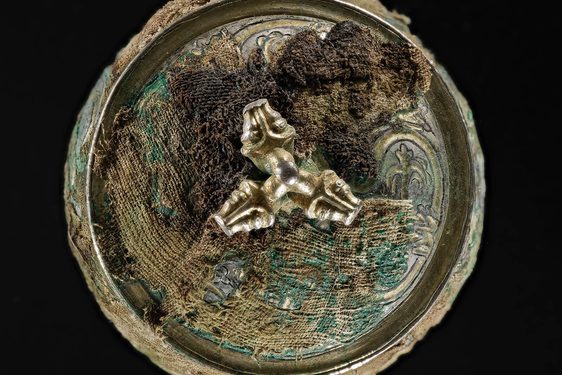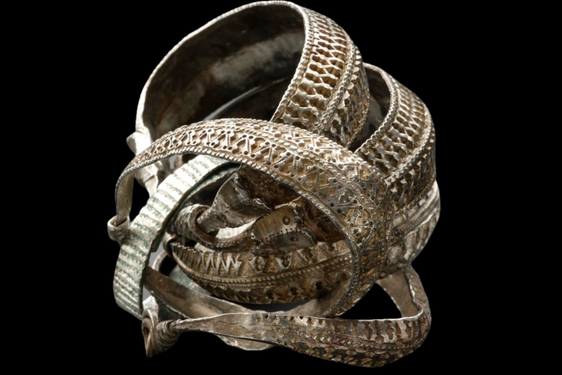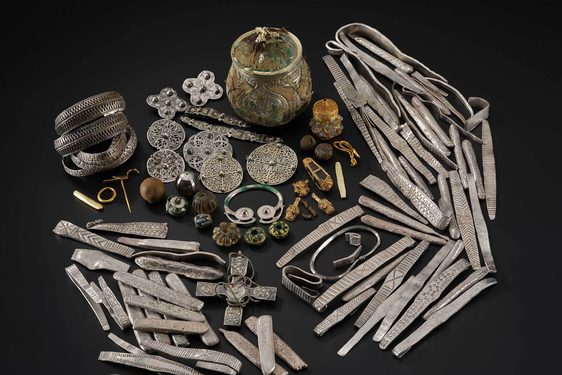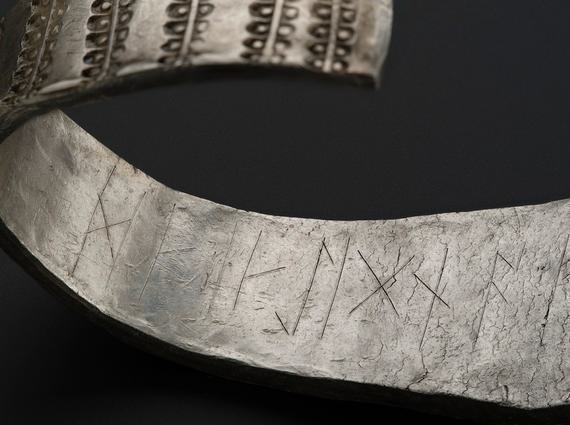
A runic revelation: Who owned the Galloway hoard?
News Story
With any hoard, some of the most common questions are about who buried it, and why.
Usually, Viking-age hoards of silver are a mix of anonymous ornaments, often hacked into pieces. If we’re lucky, there may be coins which at least help us place them in time. But with the Galloway Hoard, we have those rarest of things: actual names and messages left by its owners.
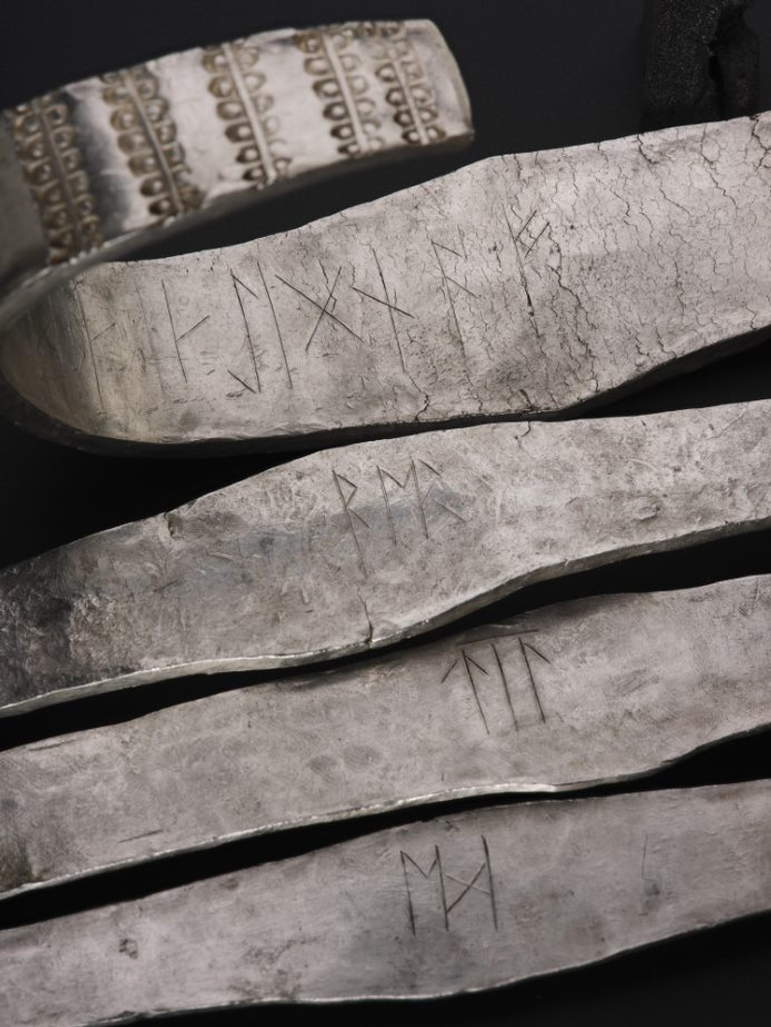
Runic inscriptions on four arm-rings, found in the larger lower deposit of hacksilver in the Galloway Hoard.
There are four runic inscriptions in the hoard itself, and one more from the surface finds near the hoard pit. As recognised and read by Dr David Parsons (University of Wales, Trinity St David), they are all written in Anglo-Saxon runic script, an alphabet used in early medieval England, and they all appear to capture words and names in the Old English language.
This is surprising for a Viking-age hoard which we might expect to use Scandinavian runes and Old Norse names. But the south west of Scotland has a number of Anglo-Saxon runic inscriptions (including the longest known example on the Ruthwell Cross near Dumfries) and the Galloway Hoard significantly contributes to our understanding of this wider context.
Here is a guide to what the runic inscriptions from the Galloway Hoard reveal about the people behind the treasure.
An inscription from the surface
The hoard was excavated on the day of discovery, and soon after the site was investigated further to establish an archaeological context. During this investigation, a small number of silver objects were found in the ploughsoil, including a fragment of arm-ring with a runic inscription.
While this arm-ring was not part of the hoard, it provided important evidence that silver arm-rings and ingots were used for commercial transactions at the site where the hoard was buried.
It had been hacked off at both ends, and folded in half. The runes were apparently written after hacking and folding, because the final rune - the T-rune, which is shaped like a small arrow - is squeezed into the space remaining near the cut edge. It reads EGGBRECT, which is easily recognisable as the common Old English name Ecgbreht, modern Egbert. A small horizontal guide-line appears above BR, and the letters EC are ligatured (the final vertical stroke of the E becomes the first vertical of the C). These are also features of the inscriptions in the hoard itself.
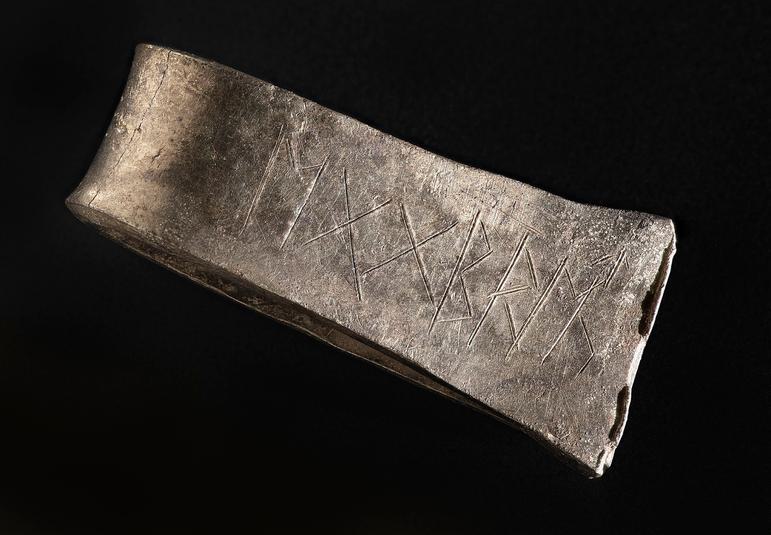
Hacked arm-ring with runic inscription reading EGGBRECT, found near the Galloway Hoard. Museum reference X.2018.12.80.
Runes in the lower deposit
The Galloway Hoard was deposited in several groups. The lidded vessel, the arm-ring cluster with gold objects, and a large deposit of hacksilver were all part of the lower level of the hoard – the objects that went into the ground first. Above these was a smaller, upper or ‘decoy’ deposit of hacksilver, including the pectoral cross.
All of the runic-inscribed objects in the hoard come from the larger lower deposit of hacksilver. This parcel, containing 15 silver ingots and 31 arm-rings, was placed in a leather bag, of which only scraps survive. Four of the broad-band arm-rings were inscribed.
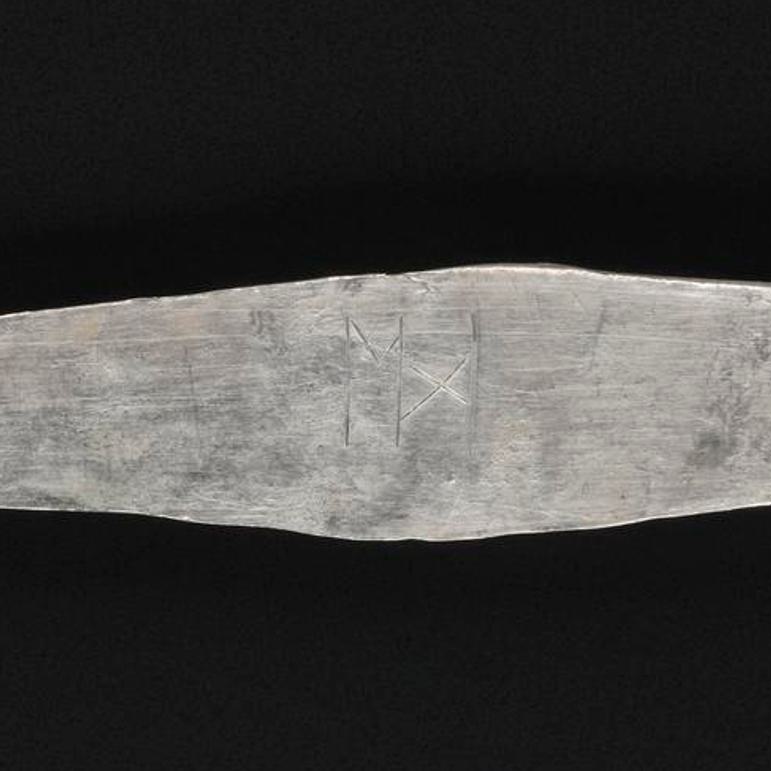
The lightest inscribed arm-ring. The inscription could stand for the Old English word 'ēad' for‘riches, prosperity’, but it could be an abbreviation for a personal name such as Edwine, Edward or Eadgar. Museum reference X.2018.12.59.
The lightest of the inscribed arm-rings weighs 23.4 grams. It is undecorated and completely flat, except for one end, which is tightly folded under. The runes ED are inscribed in the upper half of the expanded centre. Like the inscription from the surface, the runes are ligatured (the final vertical stroke of E becomes the initial stroke of D). The short message could stand for the Old English word 'ēad' meaning‘riches, prosperity’, but it could be an abbreviation for a personal name such as Edwine, Edward or Edgar.
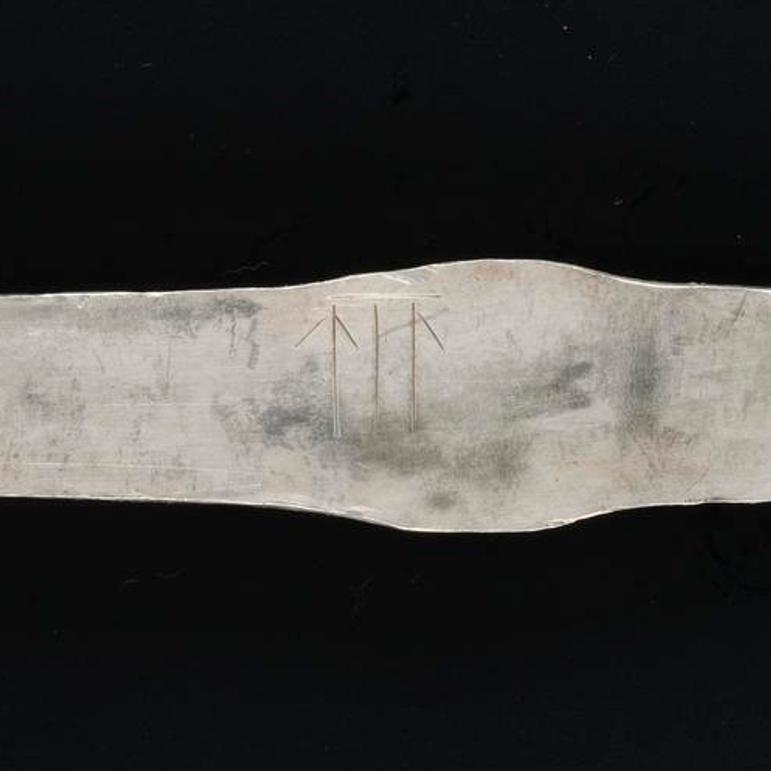
This inscription reads 'til', which is Old English for ‘good’. It could also be an abbreviation of common names like Tilred or Tila. Museum reference X.2018.12.53.
Another arm-ring, weighing 26.7 grams, is made from an undecorated thin hammered sheet of silver. This arm-ring was also left flat, with no sign it was ever previously folded or bent into shape to be worn wrapped around the arm. The runes TIL are inscribed just to left of the expanded centre, with a horizontal line above them acting as a guide. This is not a common feature of runic inscriptions, but it is shared with the ‘Egbert’ inscribed hacksilver from the surface finds. 'Til' is Old English for ‘good’ but is also a common element in personal names such as Tilred and Tila and therefore could also be an abbreviated name.
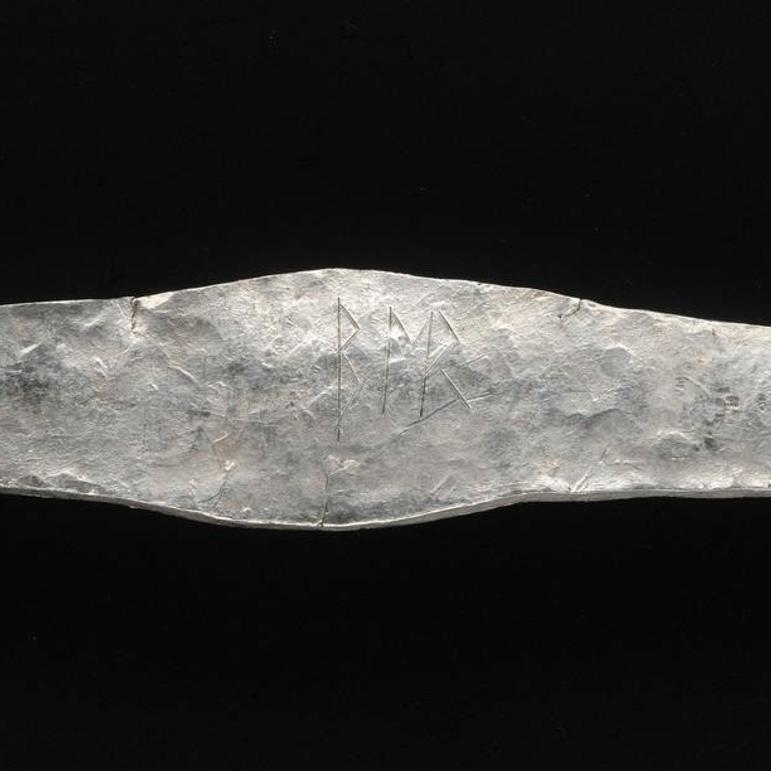
The inscription on this arm-ring reads 'BER'. It could be an abbreviation of a personal name such as Bercol, or Beorhtwulf. Museum reference X.2018.12.30
A larger arm-ring contained in the hoard is undecorated and flat, but has both ends tightly folded under. At 48.5 grams, it is roughly twice the weight of the lightest inscribed ring. The runes BER begin right at the central expansion, with the E and R runes also ligatured, a sign they may have been written by the same hand. Unlike the other short inscriptions, BER is not an Old English word, though it is the first syllable in recorded personal names like Bercol, Berwulf and Berric. This element probably derived from ‘bera’ (bear) or ‘bēor’ (beer). It seems likely, therefore, that this is another abbreviation for a personal name, which adds weight to the idea that ED and TIL are also abbreviated names.
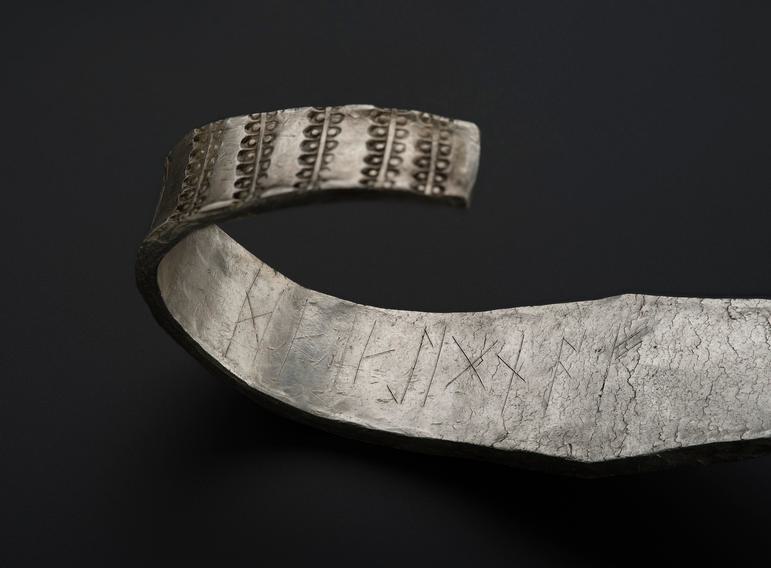
The longest inscription is the most difficult to decipher. Museum reference X.2018.12.54.
The largest and heaviest arm-ring in the hoard weighs 130.8 grams. It has the longest inscription, and has proved the most difficult to decipher. Despite using clearly legible Anglo-Saxon runes like the others, it did not at first appear to contain a coherent message. It also has an odd sequence of the rune ɨ followed by i. The letter ɨ is used to represent the thirteenth rune ᛇ, the ‘velar fricative’ represented by 'gh' in words like 'almighty'. In modern English this is silent, but in Old English it would have sounded something like the end of the Scots word 'loch'. It is rarely if ever used at the start of a word, much less followed by another vowel.
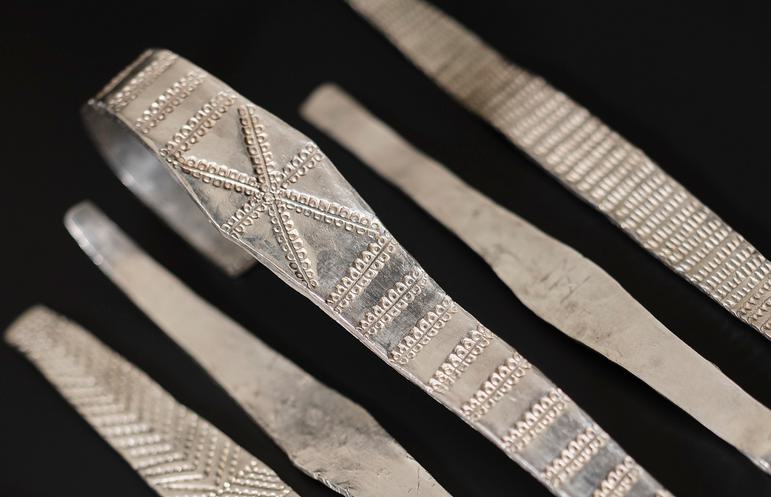
Arm-rings from the Galloway Hoard. The arm ring in the centre features the longest inscription.
The arm-ring stands out in other ways as well as being the largest in the hoard. It is decorated in typical Hiberno-Norse stamped ornament, while the other inscribed arm-rings are all plain. This required the inscription to go on the plain underside, unlike the others which all face outwards. And while the other three were on flat, thin sheet-silver that were never made into rings, this one was a finished armlet, before one end was unfolded in order to take the inscription.
The breakthrough for translation came when looking down the microscope, and it became clear the final rune had dots to either side. Centrally-placed dots like these, called puncts, could be used in medieval manuscripts to denote an abbreviation, or the name of the rune: in this case the F-rune which is called 'feoh', a word which also means ‘wealth’ or ‘property’. A new look at the inscription showed that there was possible word spacing in the runic inscription, allowing us to break it down into four words: DIS IS ƗIGNA F[EOH].
This gets us closer to one possible reading. If we allow for an odd pronunciation, it could be that DIS IS is an attempt at ‘this is’. ƗIGNA is more problematic - but the ‘gh’ in ‘almighty’ was sometimes written simply as ‘h’ in Old English. If ᛇ could be used for ‘h’ here, the text would read ‘higna’, a word which means ‘community’, particularly used for monastic or other religious communities.
With all these caveats in mind, the long inscription may well be understood as:
þis is higna feoh
This is the community’s property
So whose silver is it?
The Galloway Hoard is unique in that it provides us with several names to conjure with. A bead-pendant in the lidded vessel uses a coin of Coenwulf, King of Mercia (r. 796-821), and the rock crystal jar commemorates a Bishop Hyguald. But both of these are heirloom objects which do not reveal the owners of the hoard as gathered around the year AD 900.
The Ecgbreht arm-ring reveals the Northumbrians were using Viking-age silver arm-rings at this site. But again, this does not necessarily have to be someone associated with the hoard itself. It does share elements of its ‘handwriting’ with the runes from the hoard (the use of ligatures and guide-lines), but that might only tell us that there was one designated rune-cutter.
Three of the messages from the lower deposit of silver are possibly just simple words, but they make more sense as abbreviated personal names. It is unclear why it was necessary to shorten names at all, but if they do represent individuals, they were close enough that an initial or nickname was all that was needed to identify them.
Could the ‘community property’ referred to by the long inscription be the treasure itself? If so, does it refer only to the silver in the leather bag of the lower deposit, or the entire hoard? Was the ‘community’ the donor, or the recipient of all this wealth?
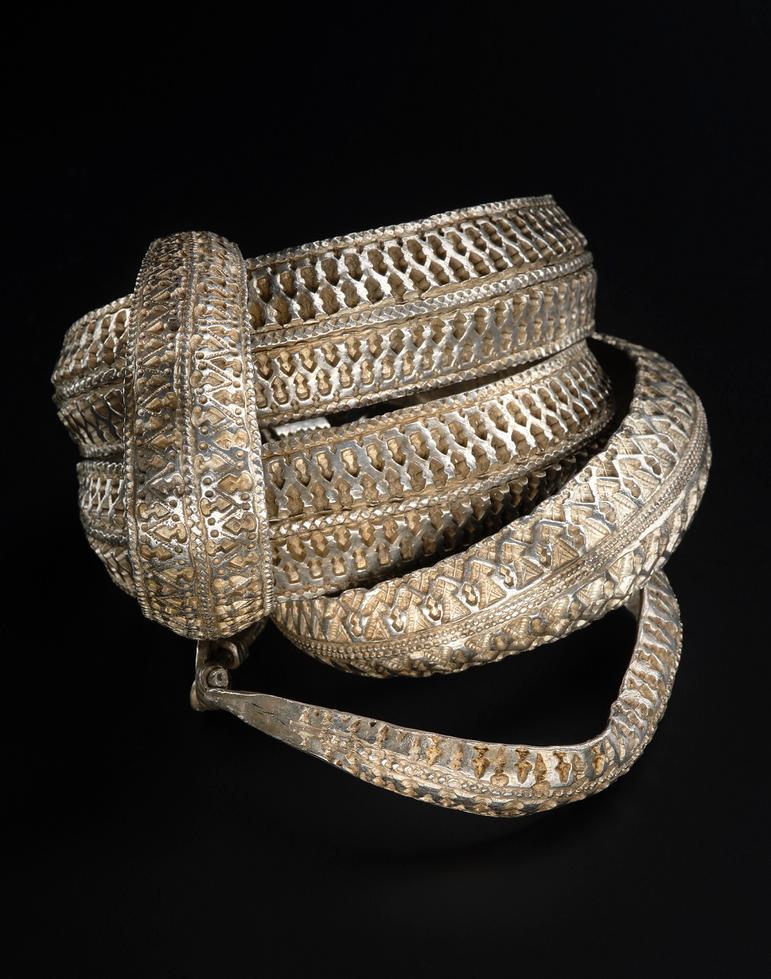
Arm-ring cluster from the Galloway Hoard. Museum reference X.2018.12.72.
And what is meant by the ‘community’ anyway? The choice of 'higna'strongly suggests this refers to a monastic community, which is interesting given the presence of clear ecclesiastical objects like the pectoral cross and bishop’s jar in the lidded vessel. The four inscriptions also match the number of complete rings bound in the arm-ring cluster. If these are no more than coincidence, then the ‘property’ or ‘wealth’ captured by the word 'feoh' might well refer to the whole treasure.
One thing is clear: this does not look like a single person’s belongings.
And the people behind it certainly seem to include Northumbrians, or at least Old English speakers, as well as ecclesiastics. We don't often associate either of these with Viking-age hoards. The lidded vessel contains many female-gendered items, and the abbreviated personal names could be male or female.
How many people knew where it was buried? Why did they ‘sign’ the objects this way unless they meant to come back for it? And why did none of them ever make it back? We are closer than ever to understanding the people behind this Viking-age hoard, but many more mysteries remain.
